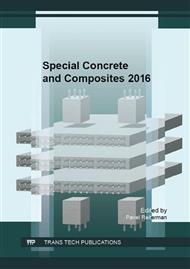[1]
F. Izzo, A. Arizzi, P. Cappelletti, G. Cultrone, A. De Bonis, C. Germinario, S.F. Graziano, C. Grifa, V. Guarino, M. Mercurio, V. Morra, A. Langella, The art of building in the Roman period (89 B.C. – 79 A.D. ): Mortars, plasters and mosaic floors from ancient Stabiae (Naples, Italy), Con. Build. Mat. 117 (2016).
DOI: 10.1016/j.conbuildmat.2016.04.101
Google Scholar
[2]
C. Nunes, Z. Slizkova, Freezing and thawing resistance of aerial lime mortar with metakaolin and a traditional water-repellent admixture, Con. Build. Mat. 114 (2016) 896–905.
DOI: 10.1016/j.conbuildmat.2016.04.029
Google Scholar
[3]
E. Vejmelková, D. Koňáková, T. Kulovaná, M. Keppert, J. Žumár, P. Rovnaníková, Z. Keršner, M. Sedlmajer, R. Černý, Engineering properties of concrete containing natural zeolite as supplementary cementitious material: Strength, toughness, durability, and hygrothermal performance, Cem. Conc. Comp. 55 (2015).
DOI: 10.1016/j.cemconcomp.2014.09.013
Google Scholar
[4]
O. Holčapek, P. Reiterman, P. Konvalinka, Fracture characteristics of refractory composites containing metakaolin and ceramic fibers. Adv. Mech. Eng. 7 (2015) Art. Nr. 1687814015573619.
DOI: 10.1177/1687814015573619
Google Scholar
[5]
M. Ghrici, S. Kenai, M. Said-Mansour, Mechanical properties and durability of mortar and concrete containing natural pozzolana and limestone blended cements, Cem. Conc. Comp. 29 (2007) 542–549.
DOI: 10.1016/j.cemconcomp.2007.04.009
Google Scholar
[6]
D. Kastis, G. Kakali, S. Tsivilis, M.G. Stamatakis, Properties and hydration of blended cements with calcareous diatomite, Cem. Conc. Res. 36 (2006) 1821–1826.
DOI: 10.1016/j.cemconres.2006.05.005
Google Scholar
[7]
D.L. Carroll, T.F. Kemp, T.J. Bastow, M.E. Smith, Solid-state NMR characterisation of the thermal transformation of a Hungarian white illite, Solid State Nucl. Magn. Reson. 28 (2005) 31-43.
DOI: 10.1016/j.ssnmr.2005.04.001
Google Scholar
[8]
M.D. Andersen, H.J. Jakobsen, J. Skibsted, Incorporation of aluminum in the calcium silicate hydrate (C-S-H) of hydrated Portland cements: a high-field 27Al and 29Si MAS NMR investigation, Inorg. Chem. 42 (2003) 2280-22877.
DOI: 10.1021/ic020607b
Google Scholar
[9]
K.J.D. Mackenzie, M.E. Smith, Multinuclear solid-state NMR of inorganic materials, Pergamon, London, (2002).
Google Scholar
[10]
R. Kondo, K. Lee, M. Diamon, Kinetics and mechanism of hydrothermal reaction in lime-quartz-water system, J. Ceram. Soc. Japan 84 (1976) 573-578.
DOI: 10.2109/jcersj1950.84.975_573
Google Scholar
[11]
C. Shi, R.L. Day, Pozzolanic reaction in the presence of chemical activators. Part I. Reaction kinetics, Cem. Conc. Res. 30 (2000) 51–58.
Google Scholar


